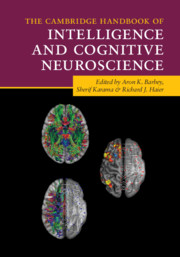Book contents
- The Cambridge Handbook of Intelligence and Cognitive Neuroscience
- Reviews
- The Cambridge Handbook of Intelligence and Cognitive Neuroscience
- Copyright page
- Dedication
- Contents
- Figures
- Tables
- Contributors
- Preface
- Part I Fundamental Issues
- 1 Defining and Measuring Intelligence
- 2 Network Neuroscience Methods for Studying Intelligence
- 3 Imaging the Intelligence of Humans
- 4 Research Consortia and Large-Scale Data Repositories for Studying Intelligence
- Part II Theories, Models, and Hypotheses
- Part III Neuroimaging Methods and Findings
- Part IV Predictive Modeling Approaches
- Part V Translating Research on the Neuroscience of Intelligence into Action
- Index
- References
2 - Network Neuroscience Methods for Studying Intelligence
from Part I - Fundamental Issues
Published online by Cambridge University Press: 11 June 2021
- The Cambridge Handbook of Intelligence and Cognitive Neuroscience
- Reviews
- The Cambridge Handbook of Intelligence and Cognitive Neuroscience
- Copyright page
- Dedication
- Contents
- Figures
- Tables
- Contributors
- Preface
- Part I Fundamental Issues
- 1 Defining and Measuring Intelligence
- 2 Network Neuroscience Methods for Studying Intelligence
- 3 Imaging the Intelligence of Humans
- 4 Research Consortia and Large-Scale Data Repositories for Studying Intelligence
- Part II Theories, Models, and Hypotheses
- Part III Neuroimaging Methods and Findings
- Part IV Predictive Modeling Approaches
- Part V Translating Research on the Neuroscience of Intelligence into Action
- Index
- References
Summary
The human brain is a complex network consisting of numerous functionally specialized brain regions and their inter-regional connections. In recent years, much research has focused on identifying principles of the anatomical and functional organization of brain networks (Bullmore & Sporns, 2009; Sporns, 2014) and their relation to spontaneous (resting-state; Buckner, Krienen, & Yeo, 2013; Fox et al., 2005) or task-related brain activity (Cole, Bassett, Power, Braver, & Petersen, 2014). Numerous studies have identified relationships between variations in network elements or features and individual differences in behavior and cognition. In the context of this monograph, studies of general cognitive ability (often indexed as general intelligence) are of special interest. In this chapter we survey some of the methodological aspects surrounding studies of human brain networks using noninvasive large-scale imaging and electrophysiological techniques and discuss the application of such network approaches in studies of human intelligence.
- Type
- Chapter
- Information
- Publisher: Cambridge University PressPrint publication year: 2021



